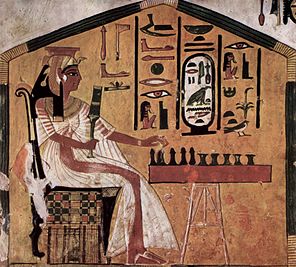Senet
Senet (or Senat) is a board game from predynastic and ancient Egypt. The oldest hieroglyph representing a Senet game dates to around 3100 BC. The full name of the game in Egyptian was zn.t n.t ḥˁb meaning the "game of passing".
History
| Senet in hieroglyphs |
|
Senet (Sn.t, "passage/gateway") |
|
Painting in tomb of Egyptian Queen Nefertari (1295-1255 BC) |
Senet is one of the oldest known board games. It has been found in predynastic and First Dynasty burials of Egypt, c. 3500 BC and 3100 BC respectively. Senet is also featured in a painting from the tomb of Merknera (3300-2700 BC). Another painting of this ancient game is from the Third Dynasty tomb of Hesy (c. 2686-2613 BC). It is also depicted in a painting in the tomb of Rashepes (c. 2500 BC).
By the time of the New Kingdom in Egypt (1550-1077 BC), it had become a kind of talisman for the journey of the dead. Because of the element of luck in the game and the Egyptian belief in determinism, it was believed that a successful player was under the protection of the major gods of the national pantheon: Ra, Thoth, and sometimes Osiris. Consequently, Senet boards were often placed in the grave alongside other useful objects for the dangerous journey through the afterlife, and the game is referred to in Chapter XVII of the Book of the Dead.
Gameplay
The Senet gameboard is a grid of 30 squares, arranged in three rows of ten. A Senet board has two sets of pawns (at least five of each and, in some sets, more, as well as shorter games with fewer). While details of the original game rules are a subject of some conjecture, Senet historians Timothy Kendall and R. C. Bell have each made their own reconstructions of the game. Their rules have been adopted by sellers of modern Senet sets.
In modern culture
- In the 1972 film Sleuth, the writer Andrew Wyke has a Senet board as part of his collection of games and automata; a partial game is in progress.
- In Rick Riordan's The Throne of Fire, Carter, Sadie Kane, and Bes play Senet against the moon god Khonsu in order to gamble for time.
- In Patricia Kennealy Morrison's Keltiad series, in the book The Copper Crown the Egyptian-based antagonists the Coranians play Senet among themselves.
- In the popular 1999 video game Tomb Raider: The Last Revelation, the player (playing as series heroine Lara Croft), must play a game of Senet in order to advance through the Tomb of Semerkhet level. If she loses the game she must take a longer route through the level, if she wins she takes a shorter route.
- In House of Anubis, Nina Martin (portrayed by Nathalia Ramos) and her friends must play a game of Senet to get through the final chamber of the underground tunnels to reach the Mask of Anubis.
- In the Nancy Drew game Tomb of the Lost Queen, you can play Senet against a computer player.
- In "Across the Sea", the 15th episode of the final season of the TV series Lost, the Man in Black finds a game of Senet and plays against his brother Jacob on the beach during a flashback.
- In Jude Watson's Beyond the Grave, the 4th book of the 39 Clues series, Amy and Dan are given a Senet board by the store owner, Sami, leading them finding the clue, Myrrh.
- In "Prisoner's Dilemma", the 21st episode of the second season of the webseries Carmilla, Laura and LaFontaine are shown playing Senet. LaFontaine corrects Laura when she incorrectly refers to it as "The ancient game of Sekhmet". In "Zones of Friendship," the 27th episode of the same season, Laura and Carmilla are shown playing. Carmilla corrects Laura when she tries to move a piece off the board without first entering the House of Beauty.
Read more:
- Mehen - another ancient Egyptian game
- Patolli - a game of pre-Columbian Mesoamerican cultures
- Royal Game of Ur - an ancient Mesopotamian game
- Tâb - a Middle Eastern game with a similar board
- Mancala-a family of similar games first found in the Middle East of over 2500 years ago, and now world-wide
COMMENTS




